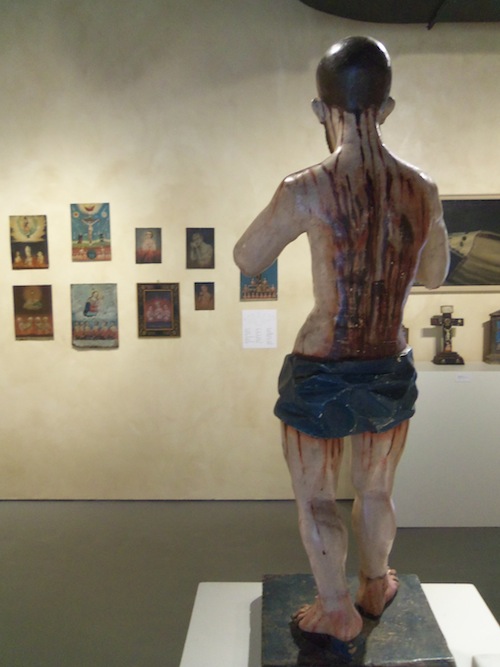Today I visited the Fullerton College Art Gallery to check out their latest art exhibit "Faith and Private Devotion: Retablos, Santos, and Animas Solas" (from the collection of Daniel and Cathy Stearns). The exhibit "examines how art and faith are deeply rooted in the spiritual life of the Mexican people. The works in the exhibit, some dating back to the 19th century, were once used to decorate churches, convents, hospitals, orphanages, while other works were placed as devotional pieces in private homes. These works are filled with many fascinating stories and personages, such as Santa Eduviges, the barefooted saint from Poland who was evoked by couples with marital problems; or San Ysidro, a poor Spanish farmer who was helped by an angel to cultivate his fields."

Retablos are small oil paintings on tin, zinc, wood or copper which venerate a multiplicity of Catholic saints. These saints were prayed to and called upon during times of crisis such as a flood, an earthquake, or some other calamity. The literal translation for "retablo" is "behind the altar." This genre of folk art, deeply rooted in Spanish history, represents the heart and soul of traditional religious beliefs in 17th, 18th, and 19th century Mexican culture.
Some of the retablos depicted the baby Jesus with the Virgin Mary, while others showed Jesus crucified.
Santos are small wooden or ivory carvings of saints and other holy figures produced for Roman Catholics in Spanish colonies in the Americas, the Caribbean, and elsewhere. They are generally characterized by a style reminiscent of the seventeenth-century Spanish Baroque style, but use a less refined technique and primitive representations of facial features and anatomy; they were probably originally often carved by priests imitating imported sculptures. They were eventually influenced by indigenous styles. They became extremely popular in the Spanish colonies, and were typically found in every Christian home and placed in churches, where some became the focus of pilgrimage. It was customary to dress them in clothes made of fabric that was often decorated with intricate embroidery. Three-dimensional images of saints are often called "bultos" in Mexico and the southwestern United States.









Anima Sola, literally "lonely soul," can take the form of either a retablo or a santo. These, however, do not depict saints, but rather the souls of sinners. The souls appear to be suffering in a fiery hell, but they are actually in purgatory, awaiting a future passage to heaven.
The exhibit, which is free and open to the public, runs through November 7, 2012. The Fullerton College Art Gallery is open Mon-Thurs from 9am-2pm.


























